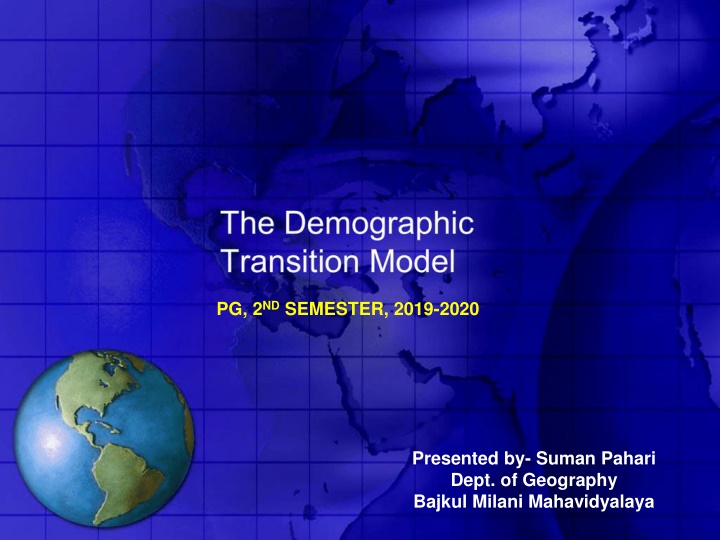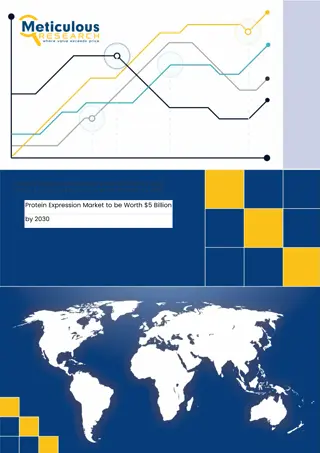
Demographic Transition: Theory, History, and Factors
Explore the concept of demographic transition, which describes the shift from high to low birth and death rates as societies develop. Learn about the history of this theory, key factors affecting demographic transition, and the models proposed by Warner Thompson and Frank Wallace Notestein.
Download Presentation

Please find below an Image/Link to download the presentation.
The content on the website is provided AS IS for your information and personal use only. It may not be sold, licensed, or shared on other websites without obtaining consent from the author. If you encounter any issues during the download, it is possible that the publisher has removed the file from their server.
You are allowed to download the files provided on this website for personal or commercial use, subject to the condition that they are used lawfully. All files are the property of their respective owners.
The content on the website is provided AS IS for your information and personal use only. It may not be sold, licensed, or shared on other websites without obtaining consent from the author.
E N D
Presentation Transcript
PG, 2ND SEMESTER, 2019-2020 Presented by- Suman Pahari Dept. of Geography Bajkul Milani Mahavidyalaya
DEMOGRAPHIC TRANSITION Demographic Transition is the transition from higher birth and death rates to lower birth and death rates as a country or region develops from a pre-industrial to an industrialized economic system. According to Johnston, A general model describing the evolution of levels of fertility and mortality over time. It has been devised with particular reference to the experience of developed countries. According to E.G. Dolan, Demographic transition refers to a population cycle that begins with a fall in the death rates, continues with a phase of rapid population growth and concludes with a decline in the birth rate. According to John R. Weeks, The process by which a country moves from high birth and death rates to low birth and death rates with population growth in the interim.
History of Demographic Transition The theory is based on an interpretation of demographic history developed in 1929 by the American demographer Warren Thompson .Adolphe Landry of France made similar observations on demographic patterns and population growth potential around 1934.In the 1945 Frank W. Notestein developed a more formal theory of demographic transition.By 2009, the existence of a negative correlation between fertility and industrial development had become one of the most widely accepted findings in social science.
Factors Affecting Demographic Transition Mortality Fertility Migration Urbanization The Quality of People
Demographic Transition Theory: Warner Thompson(1929) and Frank Wallace Notestein(1945) The demographic transition model began as a classification of populations differentiated by different combinations of fertility and mortality. The first formulation in the English demographic literature is that by Warren Thompson, published in 1929. He specified three types of countries with different rates of population growth. The first (Group A) were those with falling rates of increase and which were facing potential population decline. Although mortality in these countries was low, their rapidly declining fertility presages first a stationary, and later a declining population. Included in this category were the countries of Western Europe and overseas countries which had been settled by immigrants of European origin. Group B consists of countries in which both birth and death rates had fallen, but where death rates had declined earlier and more rapidly than birth rates. As a result their populations were growing very rapidly, until falling birth rates would bring about a stationary, and then a declining population. Included in this group were the countries of Eastern and Southern Europe. Thompson pointed out that their demographic situation was comparable to that of countries in Group A some 35 to 40 years earlier. But since death rates were now falling more rapidly than in the past, rates of natural increase in this group were greater than those experienced earlier in countries in Group A.
Countries in Group C in which neither birth nor death rates were under control were classified as 'Malthusian ,Thompson suggested that this group contained between 70 and 75 per cent of the world's population. But because data were generally sparse, he confined his analysis to three large countries in which data were available: Japan, India and Russia. He found some evidence of change in Japan, but little in either India or Russia. He predicted that population growth in Russia would be much larger than in India, because of its much larger resource base. He thought that it would take three to four decades, before many of the countries in Group C entered Group B. A good forecast! Thompson's rough forecasts of early population decline in Group A proved to be in error because he projected birth rates to decline linearly. He predicted that dire political effects would result from existing demographic trends: ' Is it probable that peoples in Groups B and C will sit quietly by and starve while the Group A countries enjoys the lion's share of the good things of the earth?'? However, he did present the transition as a continuing global generalization.
Economic Period Base of Economy Stage Birth Rates Death Rates Countries Gabon, Zambia, Somalia etc. Pre- First (1650- 1750) High High Agriculture Industrial India, Bangladesh, Brazil, China Australia, Japan, USA,Russia, France,Brita in etc. Second (1750-1850) Agriculture and Industry Transitional High Low Industry, Trade, Urban Civilization Third (1850- 1950) Industrial Low Low Services, Science and Technology Denmark, Sweden, Norway etc. Post- Forth (1950- 2000) Low Very Low Industrial
Conclusion The theory of demographic transition is the most acceptable theory of population growth. It does not lay emphasis on food supply like the Malthusian theory, nor does it develop a pessimistic outlook towards population growth. It is also superior to the optimum theory which lays an exclusive emphasis on the increase in per capita income for the growth of population and neglects the other factors which influence it. The biological theories are also one-sided because they study the problem of population growth simply from the biological angle. Thus the demographic transition theory is superior to all the theories of population because it is based on the actual population growth trends of the developed countries of Europe. Almost all the European countries have passed through the first three stages of this theory and are now in the fourth stage.








